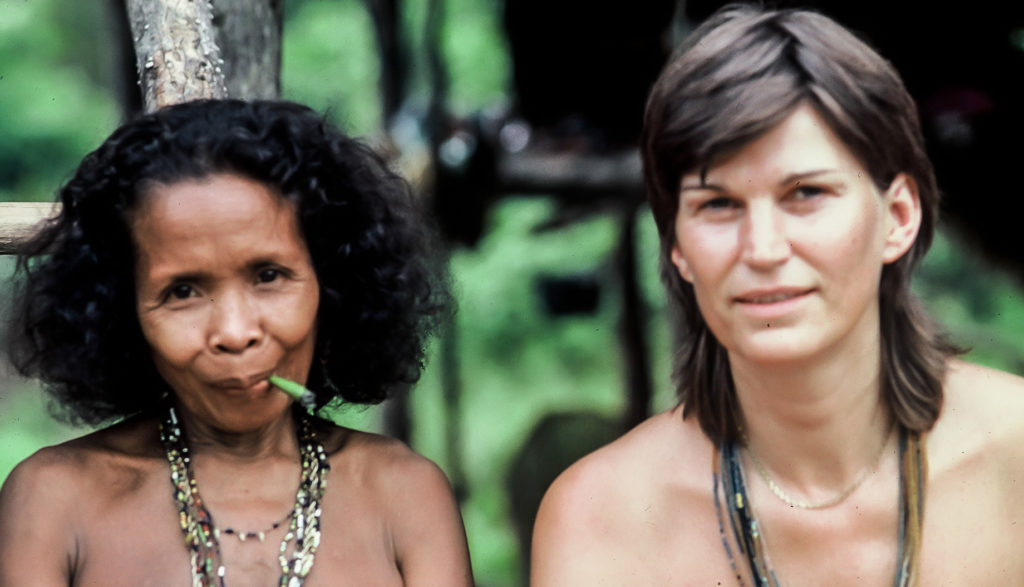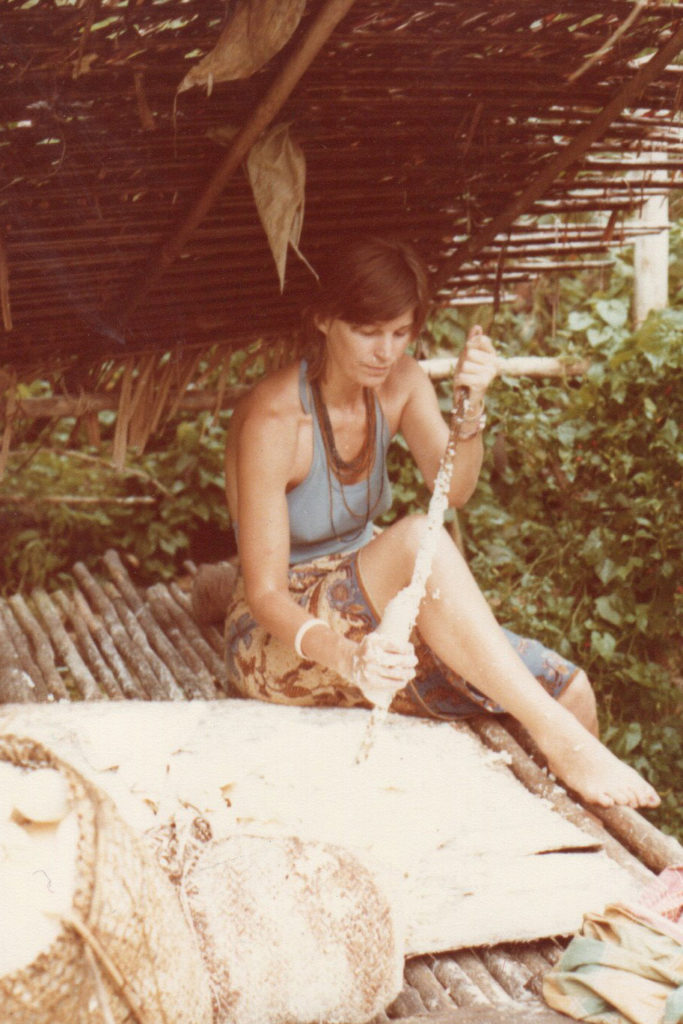Professor Signe Howell, Department of Anthropology, University of Oslo, was a distinguished anthropologist of hunter-gatherer societies, moralities and kinship. She was integral to the development of the Oslo department as outstanding within European anthropology. In 1943, when Signe was an infant, she and her mother were separated from her father, who, as a medical student, was transferred to the concentration camp of Buchenwald. Reunited in 1945, they lived in a village south of Oslo, where Signe, like her mother, learnt to read and devour English novels. Her final year of education was at the Nansen Academy, a boarding folk high school, run on humanist and anti-totalitarian lines. On graduating, she found Norway
too small for her ambitions, so left, to live in London with her English painter boyfriend.
There she entered the heady world of late 1960s bohemia. She co-founded The Ting, an experimental performance collective, which merged into The Theatre of Mistakes, a pioneering group animated by leading British conceptual artists. This group staged innovative pieces in free settings and art galleries. For example, one of their performances had participants descending stairs or raising their hands and arms very, very slowly – Signe was apparently very good at this. She was also involved in producing Wallpaper, a short-lived (now highly regarded) periodical for conceptual artworks. It
was produced as cheaply as possible, hence the use of wallpaper offcuts as its covering material. To stay afloat financially, Signe qualified as a librarian and worked at the Board of Trade for three years. At the same time, she studied Middle Eastern history as a mature student at SOAS. On graduation, her friends Susan Hiller, the conceptual artist, and Christina Toren, later
a professor of anthropology herself, persuaded her to take the diploma at the Institute of Social Anthropology, Oxford, which I, her colleague, took the following year. She was already acquainted with the subject: Hiller had graduated in American anthropology, and Signe’s first cousin once removed was Fredrik Barth. Like me, Signe found anthropology an almost
endlessly enthusing source of intellectual wonder with few apparent limits. This sentiment was enhanced by the then febrile ambience of Oxford’s Institute, heated by miserable squabbles between distinguished staff. For us, the intellectual dimensions of this jostling only made the debates even more impassioned and seemingly urgent.

Rodney Needham, her supervisor, persuaded her to shift her interests from the Middle East to the Malaysian rainforest: specifically to the Chewong, a small group living away from others, who so valued the revelatory power of dreams that they took pains to teach their children how to remember them. Signe had participated in outdoor collective dream-mapping exercises managed by Hiller and had recently dabbled in Subud, the interfaith spiritual movement. These personal explorations with dreams aligned perfectly with the Chewong, who lived within the rainforest four days’ hike away.
Signe’s fascinating fieldwork memoir (Howell 2025) details the ardours and insights of the 20 months she spent with these people. In her ethnography (Howell 1984), she openly tussled with the problem of how to analyse an egalitarian grouping which seems to thrive inthe absence of almost any structure. She chose to focus on the organizing power of morality
and the lack of separation between the Chewong and their environment. The Chewong, she came to realize, bordered on animism, where any aspect of their setting could act in the world but, crucially, viewed the world ‘with different eyes’, as they put it. In other words, as Eduardo Viveiros de Castro, the Brazilian anthropologist, was later ready to recognize, Signe had identified an Indigenous perspectivism avant la lettre. He praised her work as a precious non-Amazonian example of the general phenomenon he isolated and promoted (Viveiros de Castro 1998)
Signe continued her exploration of moralities in her next book, Societies at peace, the selected proceedings of a conference she coorganized at Edinburgh University (Howell & Willis 1986). She had started to teach there after spending a postdoctoral year in Paris with a team headed by Louis Dumont. In the book, she argued convincingly against the macho
vision of humans as the aggressor, where physical threat is a supposed core condition of human society. She and other ethnographic contributors demonstrated well the existence, albeit patchy, of groups across the globe where peacefulness was the aim and successful order of the day. The book was very well received; the carping of some reviewers only underlined how provocative her thesis was.
Signe furthered this line of investigation in The ethnography of moralities (Howell 1997), following another conference she had convened. This volume has come to be seen as a landmark work, initiating study into a new ethnographic domain that expanded remarkably rapidly. Her approach was groundbreaking in shifting anthropological attention from ethics as abstract systems to morality as lived experience. She opened pathways for examining the negotiation of moral understandings of everyday practices across diverse cultural contexts. Signe did not have tenure at Edinburgh and was very surprised one day late in her third year there to receive an unsolicited invitation to join the department at Oslo University. She accepted and moved there, together with her partner, Desmond McNeill, the development economist. They planned to stay for just a few
years but remained for the rest of her life. Within a year at Oslo, Signe was made Director of the University Museum of Cultural History. But her grand plans for turning a dusty ethnographic museum into a contemporary institution could not breach entrenched conservatism. She was relieved to return to the department and was soon promoted to professor.
Shortly before receiving the Oslo letter, she and Desmond had adopted a Nepalese daughter, Tika. The labyrinthine procedures they had to undergo to enable this transnational adoption sparked her research interest. Her next ethnography,
The kinning of foreigners, is a remarkable teasing out of the experiential, cultural, psychological and legal complexities involved (Howell 2007). She emphasized the flow and counter-flow of the process: of infants from the developing world to Western Europe; and of European approaches and categories to the donor countries. The book also underlines the
agentive dimensions of making kinship, starkly unlike the sclerotic structural approaches to the subject, which were so central to anthropology for far too long.
Signe’s book on adoption exemplifies multisite fieldwork, which was being discussed as a possible ethnographic future for the discipline in the early 2000s. But Signe steadfastly advocated the value of sustained residence in one particular site. She recognized the worth of working in several places for certain research goals but worried that anthropologists would lose a key research tool if they forsook the profound benefits of getting to know a small number of people as much in the round as possible. She took much pleasure in co-editing a book on ethnographers’ repeated visits to the same people, over decades (Howell & Talle 2011). Critics noted how this work raised a long-overdue discussion on the exact benefits of lifelong fieldwork. This sense of the resolute modulated by style was part of Signe’s general approach to life. For she never lost a strong sense of the aesthetic, which she manifested in diverse ways: a lifelong passion for contemporary art, with which
she decorated her successive homes; a desire to make each dinner for guests a work of art in itself; her imaginative construction of intricate ethnographic analyses; and so on. She herself was broadly recognized as a statuesque beauty,
a trait she shared with her sister, who, as a young woman, stumbled upon a beauty contest, entered on a whim, and left as Miss Norway. In sum, Signe anticipated the ontological turn in anthropology, helped set the moral turn, and gave other spins to the anthropological wheel. Yet, despite her multiple academic distinctions, her work has not had the more resounding echo it might have had. Though Signe had a strong sense of her own self-worth and the value of her ideas, the chest thumping of successful but self-inflated academics was not for her. She far preferred arguing her approach and her feminism in intellectually energetic but usually civilized seminars. Generations of students have lost a sometimes sharp but always supportive mentor, anthropology, one of its worthiest workers, and I, a lifelong friend.

Jeremy MacClancy
Wolfson College, Oxford University
jmacclancy@brookes.ac.uk
Howell, S. 1984. Society and cosmos: The Chewong of Peninsular Malaysia. Oxford: Oxford University Press.
— (ed.) 1997. The ethnography of moralities. London: Routledge
— 2007. The kinning of foreigners: Transnational adoption in a global perspective. Oxford: Berghahn Books.
— 2025. My anthropology: A personal and intellectual adventure. Oslo: private publication.
— & A. Talle 2011. Returns to the field: Multitemporal research and contemporary anthropology. Bloomington:
Indiana University Press.
— & R.G. Willis (eds) 1986. Societies at peace: Anthropological perspectives. London: Routledge Viveiros de Castro, E. 1998. Cosmological perspectivism in Amazonia and elsewhere. Chicago: HAU Books.
